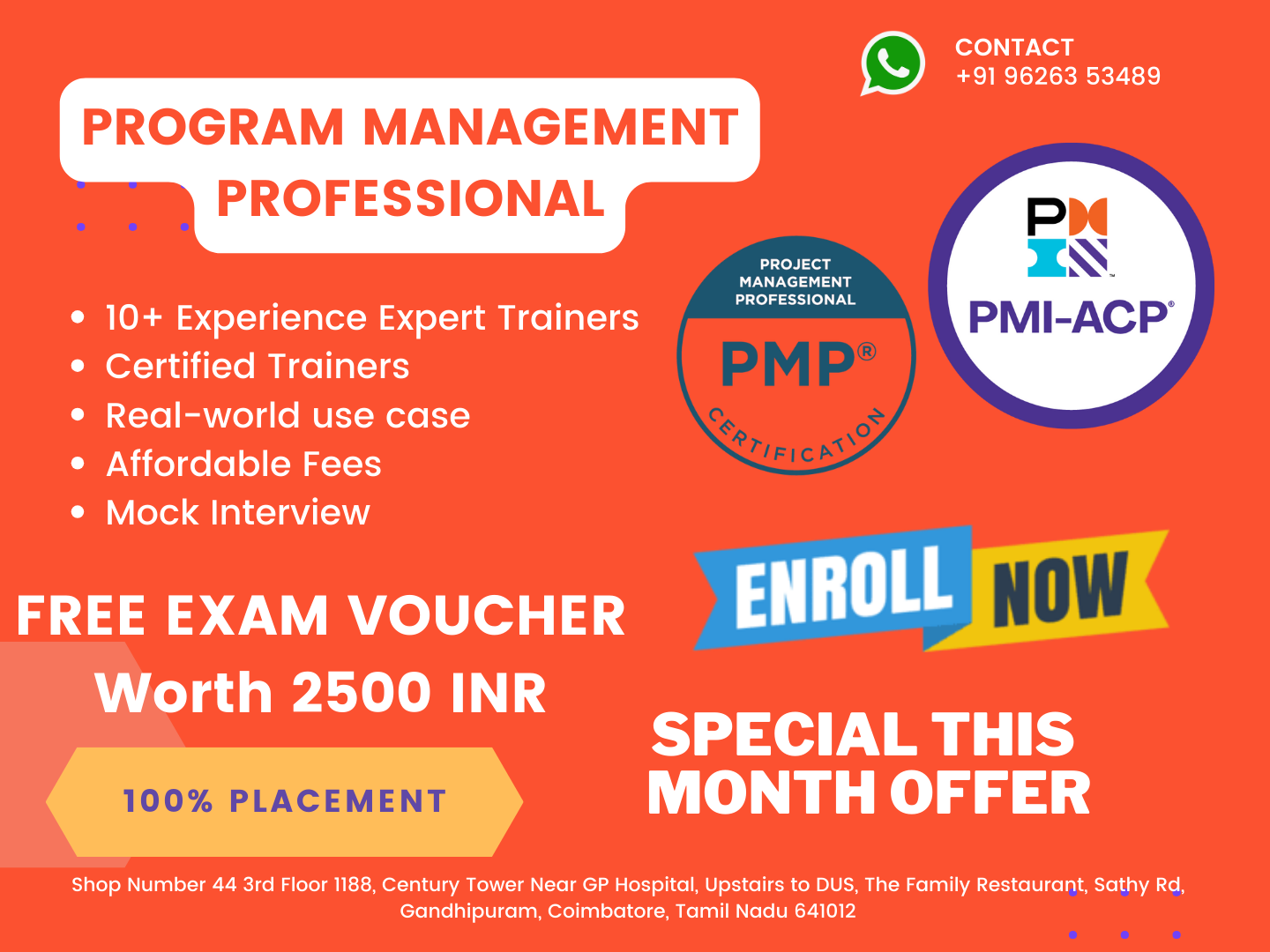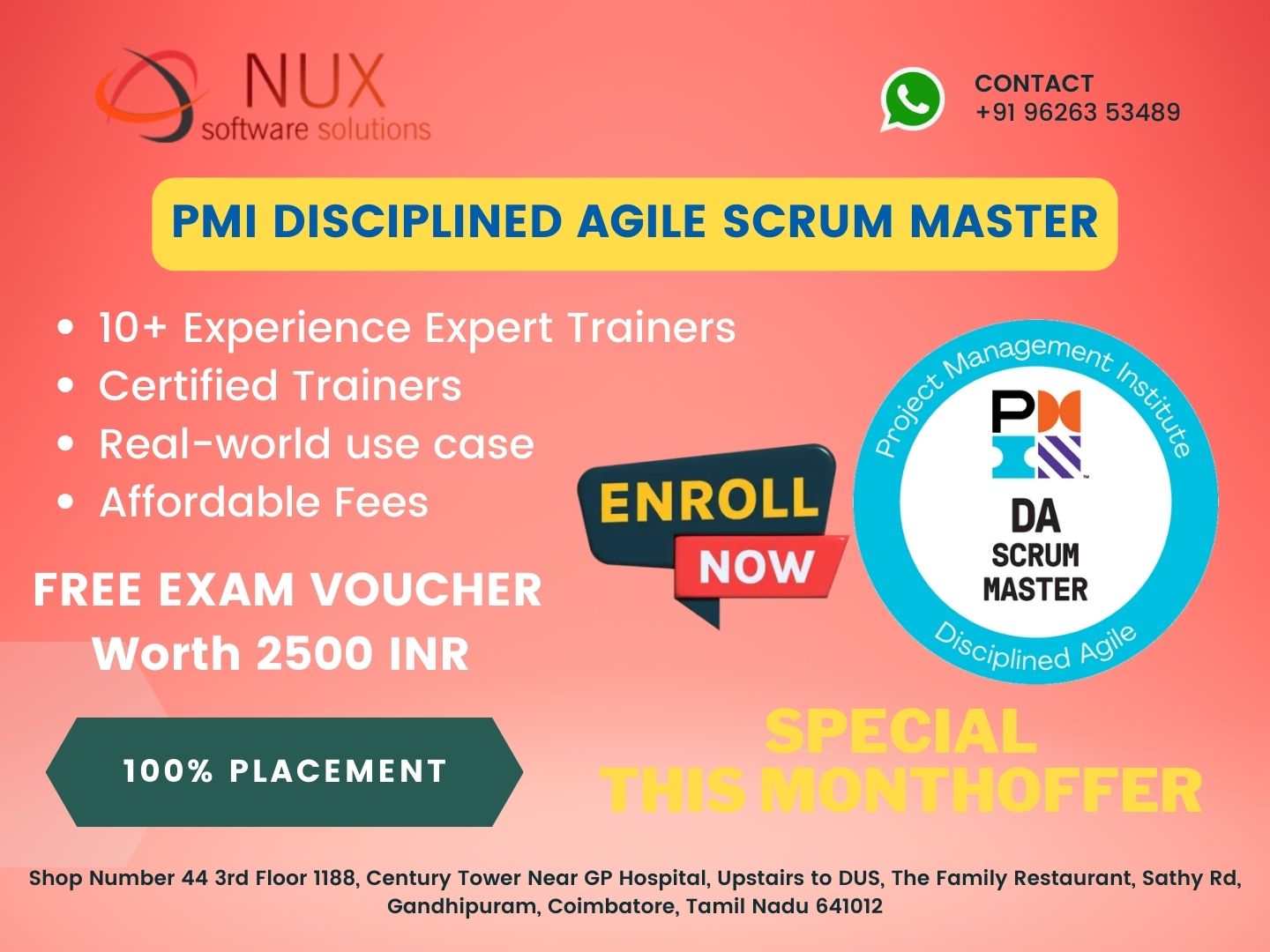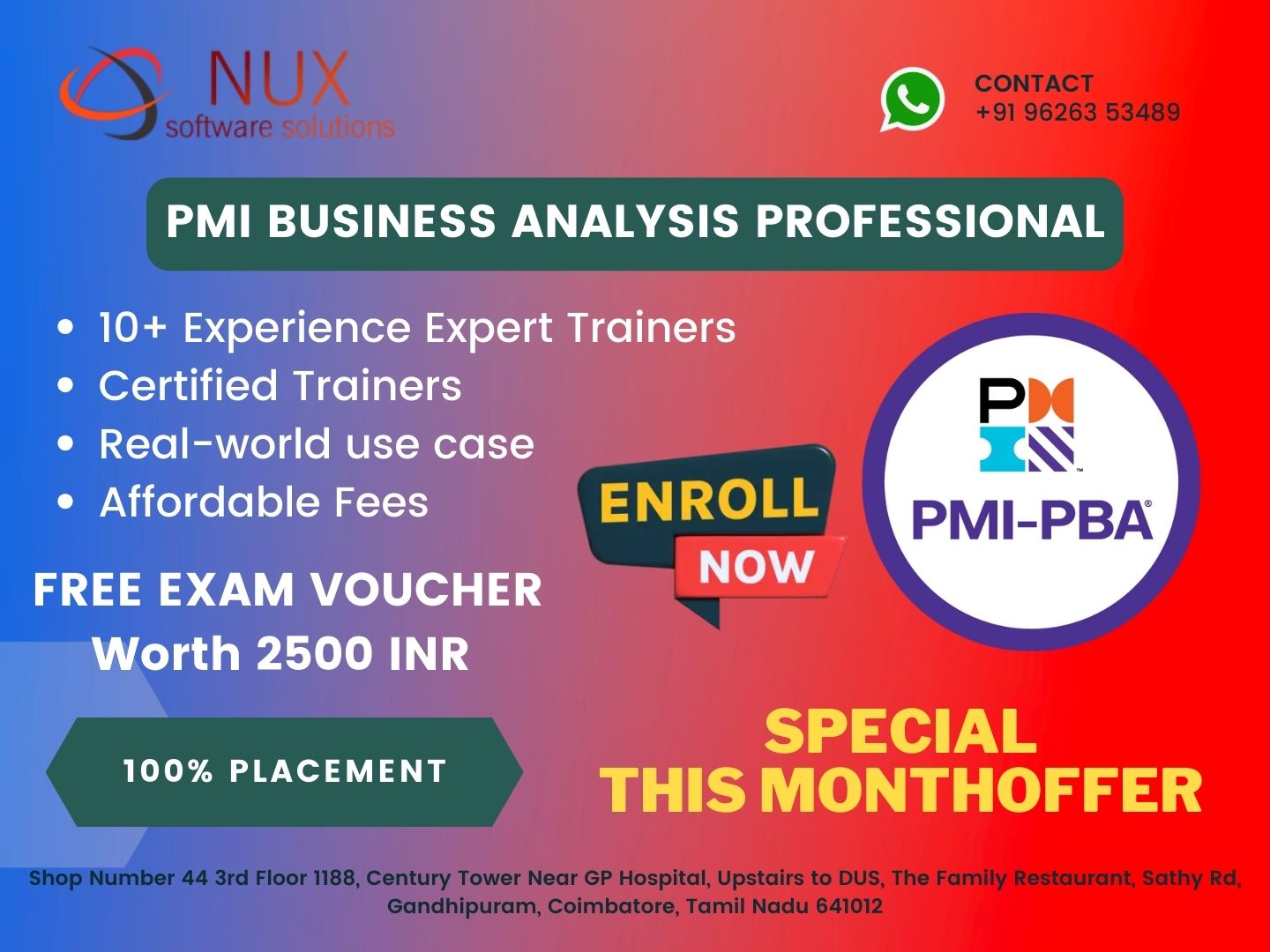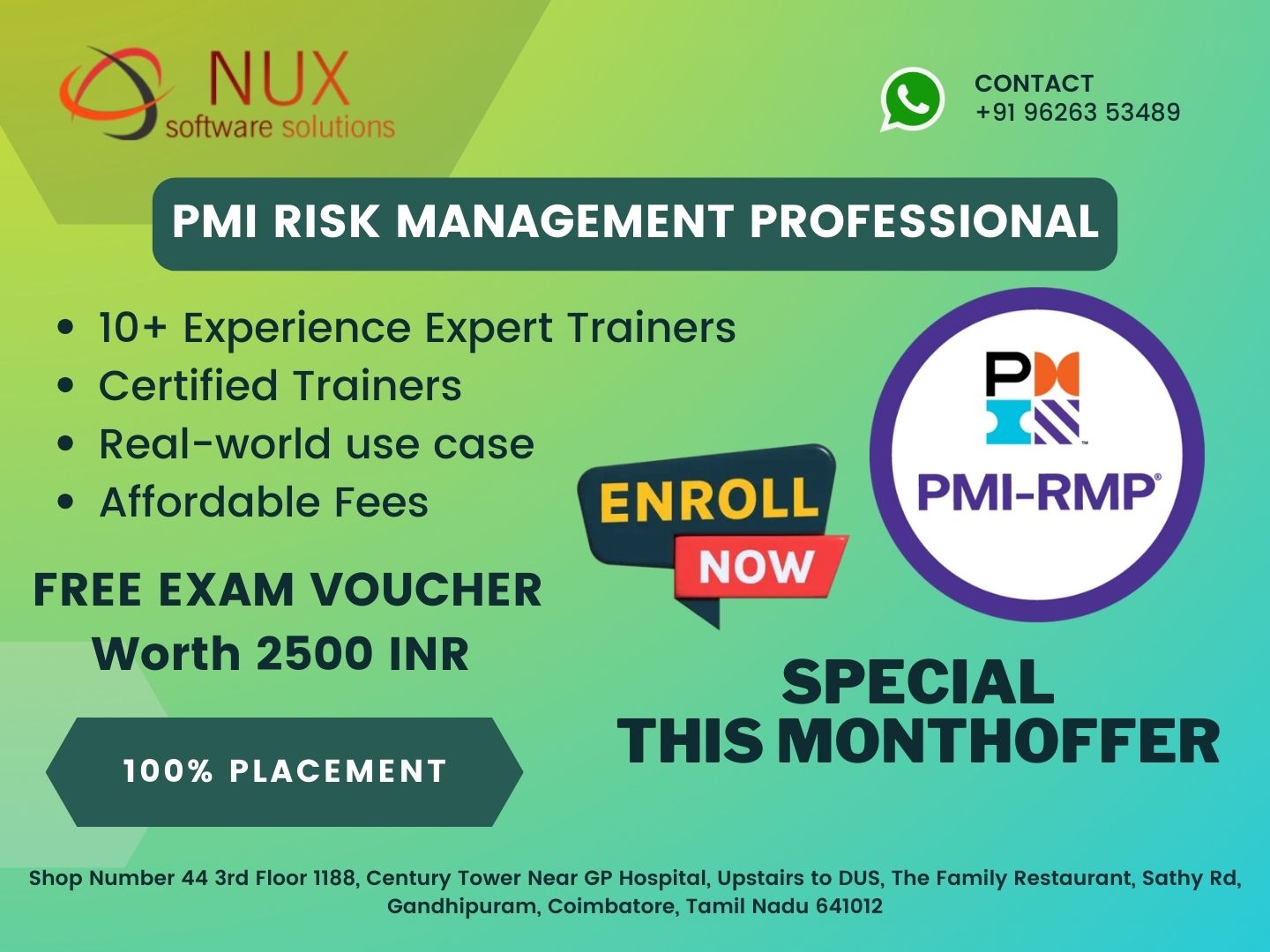Program Management Professional (PgMP)


Best PgMP® Program Management Professional (PgMP) training courses classes deliver by Nux software solutions in coimbatore. Nux software solutions in coimbatore has excellent and advanced training programs that will give you better performance & hands on experience. Our industry’s expert trainers offer a wide range of skills and experience in their graded areas.
The Training center environment is too good for professional, individual, corporate, live project training and industrial training. Labs infrastructure is advanced, well managed and you can access LAB 24X7 from anywhere. Training center has international expert trainers and they have excellent knowledge, real time industry experience.
Our Training programs combine with several innovative learning methods and delivery models. We understand your requirement and it will give you 100 percent growth for your career and provide the cost effective training programs and also work with flexibility for the trainees.
You manage multiple, related projects in a coordinated way, achieving benefits that could not occur if the projects were handled separately.
Your leadership is instrumental. With program management maturity, an organization’s projects are far more successful than without it — 76 percent compared to 54 percent according to our 2015 Pulse of the Profession® report. The Program Management Professional (PgMP)® is a visible sign of your advanced experience and skill and gives you a distinct advantage in employment and promotion.
Course Syllabus
Module
Domain I - Strategic Program Alignment - 15%
Task 1
Perform an initial program assessment by defining the program objectives, requirements, and risks to ensure program alignment with the organization’s strategic plan, objectives, priorities, vision, and mission statement.Task 2
Establish a high-level road map with milestones and preliminary estimates to obtain initial validation and approval from the executive sponsor.Task 3
Define the high-level road map and financial framework to set a baseline for program definition, planning, and execution.Task 4
Define the program mission statement by evaluating the stakeholders’ concerns and expectations to establish program direction.Task 5
Evaluate the program’s business case to develop, validate, and assess the program objectives, priority, feasibility, readiness, and alignment with the organization’s strategic plan.Task 6
Analyze the available information about organizational and business strategies, internal and external influences, and program drivers to identify and quantify the benefits that program stakeholders expect to realize using research methods such as market analysis and high-level cost-benefit analysis to develop the preliminary program scope and define the benefits realization plan.Task 7
Estimate the high-level financial framework and nonfinancial benefits of the program to obtain/maintain funding authorization and drive prioritization of projects within the program.Task 8
Evaluate program objectives relative to regulatory and legal constraints, social impacts, sustainability, cultural considerations, political climate, and ethical concerns to ensure stakeholder alignment and program deliverability.Task 9
Obtain organizational leadership approval for the program by presenting the program charter with its high-level costs, milestone schedule, and benefits to receive authorization to initiate the program.Task 10
Identify and evaluate integration opportunities and needs (for example, human capital and human resource requirements and skill sets, facilities, finance, assets, processes, and systems) within program activities and operational activities to align and integrate benefits within or across the organization.Task 11
Exploit strategic opportunities for change to maximize the realization of benefits.Knowledge specific to Domain I
- Business strategy
- Business/organization objectives* (V)
- Economic forecasting
- Feasibility analysis
- Financial measurement and management techniques
- Funding models
- Funding processes
- Intellectual property laws and guidelines
- Legal and regulatory requirements
- Marketing
- Portfolio management
- Program and constituent project charter development* (II)
- Program mission and vision
- Public relations* (IV)
- Requirement analysis techniques
- Scenario analysis
- Strategic planning and analysis* (II)
- System implementation models and methodologies
- Trend analysis
Domain II - Program Life Cycle Management - 44%
Task 1
Develop the program charter consisting of the program scope, assumptions, constraints, high-level risks, high-level benefits and their realization, timing, key stakeholders, outcomes, resource allocation, and other provisions that tie the program to the business case, thereby enabling strategic alignment using input from all stakeholders to initiate and design program and benefits.
Task 2
Translate strategic objectives into high-level program scope statements by negotiating with stakeholders, including sponsors/steering committee, to create a program scope description.
Task 3
Develop a program roadmap using the goals and objectives of the program, applicable historical information, and other available resources (for example, work breakdown structure (WBS), scope statements, and benefits realization plan) to align the program with the strategy, and manage the expectations of stakeholders, including sponsors/steering committee.
Task 4
Develop a responsibility assignment matrix by identifying and assigning program roles and responsibilities to build the program management core team and differentiate between the program and project resources.
Task 5
Define standard measurement criteria, including key performance indicators, for success and review points for all constituent projects/components by analyzing stakeholder expectations and requirements across the constituent projects/components to monitor and control the program.
Task 6
Conduct program kick-off with key stakeholders by holding meetings to familiarize the organization with the program and obtain stakeholder buy-in.
Task 7
Develop a detailed program scope statement by incorporating the program vision and all internal and external objectives, goals, influences, and variables to facilitate overall planning.
Task 8
Develop program WBS to determine, plan, and assign the program tasks and deliverables.
Task 9
Establish the program management plan and schedule by integrating plans for constituent projects/components and creating plans for supporting program functions (for example, quality, risk, communication, and resources) to effectively forecast, monitor, and identify variances during program execution.
Task 10
Optimize the program management plan by identifying, reviewing, and leveling resource requirements (for example, human resources, materials, equipment, facilities, and finance) to gain efficiencies and maximize productivity/synergies among constituent projects/components.
Task 11
Define project/program management information system (PMIS) by selecting tools and processes to share knowledge, intellectual property, and documentation across constituent projects/components to maximize synergies, savings, and benefits realization per the governance framework.
Task 12
Identify and manage unresolved project-level issues by establishing a monitoring and escalation mechanism and selecting a course of action consistent with program constraints and objectives to achieve program benefits realization.
Task 13
Develop the benefits management plan including benefits integration, transition, and sustainment by defining exit criteria to ensure all administrative, commercial, and contractual obligations are met upon program completion.
Task 14
Develop key performance indicators (KPIs) by using decomposition/mapping to manage the program and implement a scope and quality management system within the program.
Task 15
Monitor human resources for program and project roles, including subcontractors, and identify opportunities to improve team motivation (for example, develop compensation, incentive, and career alignment plans) and negotiate contracts to meet and/or exceed benefits realization objectives.
Task 16
Charter and initiate constituent projects/components by assigning project managers and allocating appropriate resources to achieve program objectives.
Task 17
Establish consistency by deploying governance framework, uniform standards, resources, infrastructure, tools, and processes to enable informed program decision-making.
Task 18
Establish a communication feedback plan and reporting process to capture lessons learned and the team’s experiences throughout the program.
Task 19
Lead human resource functions by training, coaching, mentoring, and recognizing the team to improve team engagement and achieve commitment to the program’s goals.
Task 20
Review project managers’ performance in executing the project per the project plan to maximize their contribution to achieving program goals.
Task 21
Execute the appropriate program management plans (for example, quality, risk, communication, resourcing) using the tools identified in the planning phase and by auditing the results to ensure the program outcomes are aligned with the strategy and deliver anticipated benefits.
Task 22
Consolidate project and program data using predefined program plan reporting tools and methods to monitor and control the program performance and communicate to stakeholders.
Task 23
Evaluate the program’s status to monitor and control the program while maintaining current program information.
Task 24
Approve closure of constituent projects/components upon completion of defined deliverables to ensure scope is compliant with the functional overview.
Task 25
Analyze variances and trends in costs, schedule, quality, and risks by comparing actual and forecast to planned values to identify corrective actions or opportunities.
Task 26
Update program plans by incorporating corrective actions to ensure program resources are employed effectively to meet program objectives and deliver program benefits.
Task 27
Manage program-level issues (for example, human resource management, financial, technology, scheduling) by identifying and selecting a course of action consistent with program scope, constraints, and objectives to achieve program benefits.
Task 28
Manage changes per the change management plan to control scope, quality, schedule, cost, contracts, risks, and rewards to achieve program benefits.
Task 29
Conduct impact assessments for program changes and recommend decisions to obtain approval per the governance framework.
Task 30
Manage risk per the risk management plan to ensure benefits realization.
Task 31
Complete a program performance analysis report by comparing actual values to planned values for scope, quality, cost, schedule, and resource data to determine program performance.
Task 32
Conduct program closure within the boundaries of the governance framework.
Task 33
Execute the transition and close-out of the program and all constituent projects and/or components (for example, perform administrative and PMIS program closure, archive program documents and lessons learned, and transfer ongoing activities to the functional organization) to transition program benefits and meet program objectives and/or ongoing operational sustainability.
Task 34
Conduct the post-review meetings by presenting the program performance reports to obtain feedback and capture lessons learned.
Task 35
Report lessons learned and best practices observed and archive to the knowledge repository to support future programs and organizational improvement.
Knowledge Specific to Domain II
- Benchmarking
- Closeout plans, procedures, techniques, and policies* (V)
- Decomposition techniques (for example, work breakdown structure (WBS))
- Financial closure processes* (V)
- Logistics management
- Performance and quality metrics* (III)
- Phase gate reviews* (V)
- Procurement management
- Product/service development phases
- Program and constituent project charter development* (I)
- Program and project change requests* (V)
- Program initiation plan
- Program management plans
- Quality control and management tools and techniques
- Resource estimation (human and material)
- Resource leveling techniques
- Root cause analysis
- Schedule management, techniques, and tools
- Scope management
- Service level agreements
- Statistical analysis* (V)
- Strategic planning and analysis* (I)
- SWOT analysis
- Talent evaluation
- Team competency assessment techniques
- Training methodologies* (IV)
Domain III - Benefits Management - 11%
Task 1
Develop the benefits realization plan and its measurement criteria to set the baseline for the program and communicate to stakeholders, including sponsors/steering committee.
Task 2
Identify and capture synergies and efficiencies identified throughout the program life cycle to update and communicate the benefits realization plan to stakeholders, including sponsors/steering committee.
Task 3
Develop a sustainment plan that identifies the processes, measures, metrics, and tools necessary for the management of benefits beyond the completion of the program to ensure the continued realization of intended benefits.
Task 4
Monitor the metrics (for example, by forecasting, analyzing variances, developing “what if” scenarios and simulations, and utilizing causal analysis) to take corrective actions in the program and maintain and/or potentially improve benefits realization.
Task 5
Verify that the close, transition, and integration of constituent projects/components and the program meet or exceed the benefit realization criteria to achieve the program’s strategic objectives.
Task 6
Maintain benefits register and record program progress to report the benefit to stakeholders via the communications plan.
Task 7
Analyze and update the benefits realization and sustainment plans for uncertainty, risk identification, risk mitigation, and risk opportunity to determine if corrective actions are necessary and communicate to stakeholders.
Task 8
Develop a transition plan to operations to guarantee the sustainment of products and benefits delivered by the program.
Knowledge Specific to Domain III
- Benefit optimization
- Business value measurement
- Decision tree analysis
- Maintenance and sustainment of program benefits post-delivery
- Performance and quality metrics* (II)
- Program transition strategies
Domain IV - Stakeholder Engagement - 16%
Task 1
Identify stakeholders, including sponsors/steering committee, and create the stakeholder matrix to document their position relative to the program.
Task 2
Perform stakeholder analysis through historical analysis, personal experience, interviews, knowledge base, review of formal agreements (for example, request for proposal (RFP), request for information (RFI), contracts), and input from other sources to create the stakeholder engagement plan.
Task 3
Negotiate the support of stakeholders, including sponsors/steering committee, for the program while setting clear expectations and acceptance criteria (for example, KPIs) for the program benefits to achieve and maintain their alignment with the program objectives.
Task 4
Generate and maintain visibility for the program and confirm stakeholder support to achieve the program’s strategic objectives.
Task 5
Define and maintain communications adapted to different stakeholders, including sponsors/steering committee, to ensure their support for the program.
Task 6
Evaluate risks identified by stakeholders, including sponsors/steering committee, and incorporate them in the program risk management plan, as necessary.
Task 7
Develop and foster relationships with stakeholders, including sponsors/steering committee, to improve communication and enhance their support for the program.
Knowledge Specific to Domain IV
- Customer relationship management
- Customer satisfaction measurement
- Expectation management
- Public relations* (I)
- Training methodologies* (II)
Domain V - Governance - 14%
Task 1
Develop program and project management standards and structure (governance, tools, finance, and reporting) using industry best practices and organizational standards to drive efficiency and consistency among projects and deliver program objectives.
Task 2
Select a governance framework structure including policies, procedures, and standards that conforms program practices with the organization’s governance structure to deliver program objectives consistent with organizational governance requirements.
Task 3
Obtain authorization(s) and approval(s) through stage gate reviews by presenting the program status to governance authorities to proceed to the next phase of the program.
Task 4
Evaluate key performance indicators (for example, risks, financials, compliance, quality, safety, and stakeholder satisfaction) to monitor benefits throughout the program life cycle.
Task 5
Develop and/or utilize the program management information system (PMIS), and integrate different processes as needed, to manage program information and communicate status to stakeholders.
Task 6
Regularly evaluate new and existing risks that impact strategic objectives to present an updated risk management plan to the governance board for approval.
Task 7
Establish escalation policies and procedures to ensure risks are handled at the appropriate level.
Task 8
Develop and/or contribute to an information repository containing program-related lessons learned, processes, and documentation contributions to support organizational best practices.
Task 9
Identify and apply lessons learned to support and influence existing and future programs or organizational improvement.
Task 10
Monitor the business environment, program functionality requirements, and benefits realization to ensure the program remains aligned with strategic objectives.
Task 11
Develop and support the program integration management plan to ensure operational alignment with program strategic objectives.
Knowledge Specific to Domain V
- Archiving tools and techniques
- Business/organization objectives* (I)
- Closeout plans, procedures, techniques, and policies* (II)
- Composition and responsibilities of the program management office (PMO)
- Financial closure processes* (II)
- Go/no-go decision criteria
- Governance frameworks
- Governance processes and procedures
- Metrics definition and measurement techniques
- Performance analysis and reporting techniques (for example, earned value analysis)
- Phase gate reviews* (II)
- Program and project change requests* (II)
- Statistical analysis* (II)



